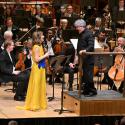An ongoing series celebrating musicians' birthdays.
7 January 1907: This week, by cosmic or other coincidence, has the birthdays of four composers who wrote some of the most interesting 20th-century music for the piano. Francis Poulenc here plays his Piano Concerto for Two Pianos with Jacques Fevrier.
7 January 1907: This week, by cosmic or other coincidence, has the birthdays of four composers who wrote some of the most interesting 20th-century music for the piano. Francis Poulenc here plays his Piano Concerto for Two Pianos with Jacques Fevrier.
The piece was been dismissed by Klemperer, among others, as little more than a mere divertissement - the tunes, including a section inspired by Balinese gamelan, waft in and out "like the models on a Paris Fashion show" as one critic put it, never to be seen again. It was played to great effect at the first night of the Proms last summer by the Labeque Sisters.
6 January 1872: Alexander Scriabin's 9th Piano Sonata, here played by Yevgevy Sudbin, nicknamed the "Black Mass" is a complex and mysterious work based on unstable minor 9th intervals. Known for his synesthesia, where colours and sounds are fused, when he died he was planning a megalomaniacal piece called Mysterium, which was to last seven days and nights and would bring about the end of the world, to be performed in the Himalayas. His coloured keyboard (illustration of keyboard and the colours Scriabin associated with notes, right) is preserved in his apartment near the Arbat in Moscow, now a museum.
Known for his synesthesia, where colours and sounds are fused, when he died he was planning a megalomaniacal piece called Mysterium, which was to last seven days and nights and would bring about the end of the world, to be performed in the Himalayas. His coloured keyboard (illustration of keyboard and the colours Scriabin associated with notes, right) is preserved in his apartment near the Arbat in Moscow, now a museum.
5 January 1880: As pianist Marc-Andre Hamelin suggests in this video, you have to give Nicolai Medtner a few listens before he gets under your skin. Here, he plays the Scherzo from the Sonata Romantica.
4 January 1874: Josef Suk's Le Desir, played by Lucas Vondracek. "Lush" and "tidy" In the words of TV's Gavin and Stacey.
4 January 1710: A couple of centuries earlier, Giovanni Pergolesi's Stabat Mater was the most printed piece of music of the 18th century here sung by the sublime Andreas Scholl and Barbara Bonney to a slide show of images of the Virgin Mary. The song is about the misery of Mary at the crucifixion.
8 January 1947: From the sublime to the desperately publicity-seeking. The earliest manifestation of David Bowie, then Davy Jones, on YouTube is his appearance aged 17 in November 1964 as the founder of the Society for the Prevention of Cruelty to Long-Haired Men.
6 January 1872: Alexander Scriabin's 9th Piano Sonata, here played by Yevgevy Sudbin, nicknamed the "Black Mass" is a complex and mysterious work based on unstable minor 9th intervals.
 Known for his synesthesia, where colours and sounds are fused, when he died he was planning a megalomaniacal piece called Mysterium, which was to last seven days and nights and would bring about the end of the world, to be performed in the Himalayas. His coloured keyboard (illustration of keyboard and the colours Scriabin associated with notes, right) is preserved in his apartment near the Arbat in Moscow, now a museum.
Known for his synesthesia, where colours and sounds are fused, when he died he was planning a megalomaniacal piece called Mysterium, which was to last seven days and nights and would bring about the end of the world, to be performed in the Himalayas. His coloured keyboard (illustration of keyboard and the colours Scriabin associated with notes, right) is preserved in his apartment near the Arbat in Moscow, now a museum.5 January 1880: As pianist Marc-Andre Hamelin suggests in this video, you have to give Nicolai Medtner a few listens before he gets under your skin. Here, he plays the Scherzo from the Sonata Romantica.
4 January 1874: Josef Suk's Le Desir, played by Lucas Vondracek. "Lush" and "tidy" In the words of TV's Gavin and Stacey.
4 January 1710: A couple of centuries earlier, Giovanni Pergolesi's Stabat Mater was the most printed piece of music of the 18th century here sung by the sublime Andreas Scholl and Barbara Bonney to a slide show of images of the Virgin Mary. The song is about the misery of Mary at the crucifixion.
8 January 1947: From the sublime to the desperately publicity-seeking. The earliest manifestation of David Bowie, then Davy Jones, on YouTube is his appearance aged 17 in November 1964 as the founder of the Society for the Prevention of Cruelty to Long-Haired Men.













Add comment